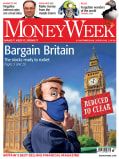Inflation: what the Fed really wants
The US Federal Reserve wants us to believe hyper-inflation is looming. And analysts predicting it are doing Bernanke's dirty work for him, argues Adrian Ash.
Here's a thought: that tiny handful of investors and analysts warning how Fed policy risks hyper-inflation are in fact doing the central bank's work.
The Fed wants you to believe hyperinflation is looming. Or at least, it should want that, if doubling its balance-sheet purchasing and lending against investment junk is going to work the wonders that modern central-bank theory says it can. And the Fed certainly wants you to believe it will stop at nothing to avoid deflation ("whatever means necessary" as the chairman put it back in 2002).
So anyone touting the hyperinflation riskin public is playing the shill, a decoy seemingly unconnected proclaiming the miracle powers of Dr.Ben Bernanke's snake oil to CNBC anchors at every chance.
Subscribe to MoneyWeek
Subscribe to MoneyWeek today and get your first six magazine issues absolutely FREE

Sign up to Money Morning
Don't miss the latest investment and personal finances news, market analysis, plus money-saving tips with our free twice-daily newsletter
Don't miss the latest investment and personal finances news, market analysis, plus money-saving tips with our free twice-daily newsletter
In fact, they're doing the Fed's work better than the Federal Reserve itself. Really.
"The major danger with a zero lower bound for the interest rate," said Swedish policy-wonk Lars Svensson [pdf] (also a Princeton colleague of the Fed chief and his credit-bubble associate Paul Krugman) in a speech earlier this year, "is that inflation expectations will be too low and even negative, and that the real interest rate will thus become too high."
With it so far? Slashing interest rates to the very minimum of 0% suggests inflation has vanished, at least in the central bank's eyes. But that, in turn, reduces the rate of inflation expected by consumers, investors and business. Central banks are credible forecasters, you see. At least in central-bank eyes. So in Svensson's philosophy, the zero-rate solution to falling inflation proves self-fulfilling as people hoard cash and sit tight in bonds.
"It is thus necessary to... counteract expectations of falling inflation, and preferably to create expectations of higher inflation," Svensson went on. But "as Paul Krugman put it" says the Riksbank's deputy governor, "How will the central bank 'credibly promise to be irresponsible'...?
Heaven knows the Fed's trying. (So's Krugman, to no one's surprise.) But while it's embraced credible recklessness, the Fed's stop short of French kissing it.
Why so coy...?
"We have a very serious recession, we have a 9.4% unemployment rate," said San Fran Fed governor Janet Yellen in a speech in California on Tuesday. "If we were not at zero, we would be lowering the funds rate...We should want to do more."
Just how much further would the Fed go all the way to hyperinflation perhaps? Racing to first base, "The vigorous policy actions of the Fed and other central banks, combined with sizable fiscal stimulus here and abroad, have sent a clear message that deflation won't be tolerated," Yellen said.
"Based on measures of inflation expectations," she went on, apparently reading straight from Svensson, "the public appears confident that the Fed will adopt policies that will maintain a low, positive rate of inflation. Evidently, the credibility that the Fed and other central banks have built over the past few decades in bringing inflation down has spilled over into a belief that we won't allow inflation to get too low either."
Steady on, cheeky! Second base next, and "A glance at history shows that many countries with massive structural deficits and without an independent central bank turned to the printing press to pay off their debts," Yellen continued.
Straight to third then, and "That's a recipe for high inflation and, in some cases, hyperinflation."
Gulp, almost home! But then, somewhere between third and fourth base, the Fed's gone shy and rebuttoned its blouse. Because "I don't believe the United States faces that threat," Yellen said, showing the come-on to be just one big tease.
"Looking back in history, runaway fiscal deficits have often been accompanied by high inflation," she explained in Tuesday's speech in the bankrupt state of California. "But, since World War II, such a relationship has only held in developing countries. In countries with advanced financial systems and histories of low inflation, no such connection is found."
Oh man, what a let down! Who's gonna put out hyperinflation if not the Fed...?
"In order to make up for the collapse of credit, we are effectively creating money," said George Soros, the legendary if only occasionally accurate hedge funder, at a Washington forum in March. "If and when credit is restarted, you would then have an incredibly swollen monetary base, which, if it were leveraged, you would have an explosion of inflation."
The trouble comes, as Lars Svensson guessed back in January, with that "if and when". Because it opens the door to the idea that a central bank might opt instead to withdraw all this new money after the deflation panic has ended. And that in itself is enough to make creating it useless. Pointing to Japan's five-year experiment with 'Quantitative Easing' between March 2001 and March 2006, said Svensson, boosting the monetary base by some 70% failed to "noticeably affect expectations of inflation and the future price level.
"For example, the Yen did not depreciate as it should otherwise have done. Firms and households clearly believed that the expansion of the monetary base was temporary and not permanent, which subsequently proved to be true. The monetary base fell back to normal levels when the interest rate was later raised to above zero."
Sure, the Bank of Japan's trillions did triple Japanese gold prices. But even with gold refusing to drop back against the dollar right now, eagle-eyed readers will note that, quite apart from the urgent debate in Europe, the US authorities are at pains to deny they need an 'exit plan' any time soon. White House advisor Christina Romer made that much plain in last week's Economist magazine, blaming the double-dip depression of 1937 on "an unfortunate, and largely inadvertent, switch to contractionary fiscal and monetary policy." Yellen said it again Tuesday.
So Team Bernanke have got the right idea at least on Planet Svensson if not the right level of irresponsibility just yet. Slip a little vodka into their juice though, and they might start talking up inflation like Alan Greenspan, Bernanke's predecessor and the Maestro himself, writing last week in the Financial Times. He tried to spook everyone out of cash and into the stores by warning of a decade of inflation ahead!
"A pending avalanche of government debt is about to be unloaded on world financial markets," Sir Alan of Greenspan warned sagely, almost visibly winking from behind those enormous spectacles. "The need to finance very large fiscal deficits during the coming years could lead to political pressure on central banks to print money to buy much of the newly issued debt."
There, now that's the way to do it! Greenspan on song, while the Bernanke Fed tip-toes around stating its aim:
Spark inflation and leave it to burn. Because putting it out worsened both the Great Depression and Japan's "lost decade" the one that started two decades ago and hasn't yet ended. Everyone who's anyone in monetary theory knows that.
And if they claim otherwise, maybe they're the ones kidding.
Adrian Ash is editor of Gold News and head of research at BullionVault
Adrian has written all things gold related from if it’s worth buying, what the real price of gold should be and what’s the point of gold for MoneyWeek. He has also written for other leading money titles on his gold expertise including Business Insider, Forbes, City A.M, Yahoo Finance and What Investment Magazine. Now Adrian is head of the research desk at BullionVault, a physical market for gold and silver for private investors online.
-
 Private school fees soar and VAT threat looms – what does it mean for you?
Private school fees soar and VAT threat looms – what does it mean for you?Rising private school fees could see more than one in five parents pull their children out of their current school. Before you remortgage, move house or look to grandparents for help, here’s what you need to know.
By Katie Williams Published
-
 Best and worst UK banks for online banking revealed
Best and worst UK banks for online banking revealedWhen it comes to keeping your money safe, not all banks are equal. We reveal the best and worst banks for online banking when it comes to protecting your money from scams
By Oojal Dhanjal Published